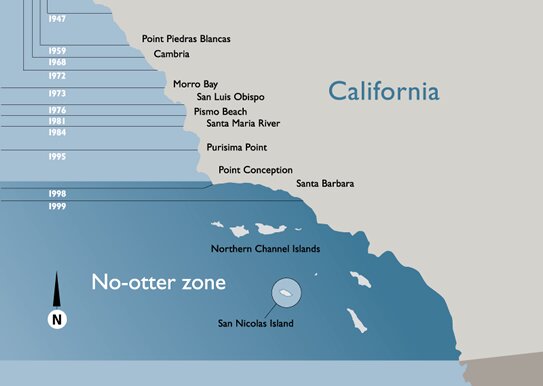no otter zone
Southern Sea Otters historically ranged throughout the California coast but were hunted to near extinction by the early 1900’s. Protected under the Endangered Species Act (ESA) in 1977, the sea otter population began to grow but was isolated to the central California Coast. Under the ESA and Marine Mammal Protection Act, Federal agencies are charged with managing sea otters to their optimum sustainable population level (OSP).
In 1987, the US Fish and Wildlife Service (FWS), the organization mandated to facilitate the recovery of the California Sea Otter, translocated (moved) an experimental population of sea otters to San Nicolas Island. The creation of a second sea otter population was part of a Recovery Plan to ensure the likelihood of sea otter’s persisting in the event a catastrophic oil spill occurred on the California Coast.
Fishing and oil industries opposed the project because they perceived the protections afforded sea otters by federal law as onerous and threatening their industry interests. The Navy objected as well. Congress authorized the project on the condition that FWS include a sea otter “management zone” (a.k.a. the No Otter Zone) to protect fishing, oil, and military interests.

The “No-Otter” Zone covered all waters south of Pt. Conception to the Mexico Border.
The no-otter zone covered a vast area from Point Conception to the border of Mexico – all of Southern California and the Channel Islands. The program dictated that FWS would remove any otters found in the No Otter Zone. The policy also said that if the program failed to meet numeric objectives (a population of 200) the FWS would declare the program a failure and end the No Otter Zone. Of the initial experimental population of 140 sea otters, there are fewer than 60 today, 25 years after translocation.
Translocation failed.
For years FWS pursued sea otters wandering the zone at huge taxpayer cost and sometimes resulting in the death of the hapless otter. In 2000, FWS determined that the containment program would jeopardize the southern sea otter population and removal of sea otters from the management zone was discontinued pending reevaluation – but the zone stayed on the map. Sea otters in the No Otter Zone were not entitled to full protection under the ESA and MMPA and receive less protection than otters north of Pt. Conception.
In 2005, FWS proposed to end the No Otter Zone and called for public comment. The Otter Project rallied its members and supporters to show support for the sea otter. The response was overwhelming, and FWS received over 20,000 comments! Following the public comment period, FWS promised to release its final decision by the end of 2006. This never happened. So in late 2009, The Otter Project and the Environmental Defense Center sued the FWS for inaction on determining whether the “no otter zone” has failed.
What’s happening now?
- We settled our lawsuit with the USFWS and in January 2013 the No Otter Zone was no more. We won!
- On July 31, 2013, the California Sea Urchin Commission (“CSUC”), California Abalone Association, California Lobster and Trap Fishermen’s Association, and Commercial Fishermen of Santa Barbara filed suit against the USFWS for ending the No Otter Zone.
- On August 12, 2013, The Otter Project, Environmental Defense Center, and Los Angeles Waterkeeper filed motions to intervene as Defendants in the action.
- On March 3, 3013 Judge Lilian Gee threw-out the fisherman’s lawsuit stating “the Court determines that Plaintiffs’ suit is a facial challenge to the 1987 Final Rule and is thus time-barred under Section 2401(a). Accordingly, Defendants’ motion to dismiss is GRANTED.” We Won AGAIN!
- On April 11, 2014, the Fishermen appeared to the 9th Circuit Court of Appeals.
- On April 7, 2015 Judge Gee approved The Otter Project’s request to intervene.
- The NOZ went to trial August 28, 2015.
- Sea Otters and The Otter Project win again! The judge ruled that the fishermen’s interpretation of the law would lead to “an absurd result.”
What’s happening with the Sea Otters?
- Sea Otters are moving south and have recently been spotted as far south as the US / Mexico border. Pups have been spotted near Santa Barbara.
- Citizens of Santa Barbara are once again enjoying the presence of charming otters.
- Angry fishermen put the sea otters in a precarious position; The Otter Project is seeking funds to start an Otter Watch program in Santa Barbara and LA Counties.
- Anecdotal evidence suggests otters in the No Otter Zone are being harassed, threatened and even shot and killed.
The Legal documents
Facebook Wordpress Twitteryoutubemeet